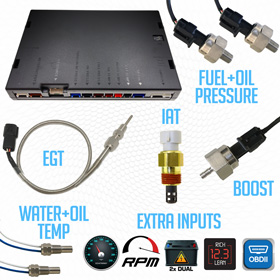
JRP 14 in 1 OLED multi gauge display v2.5
Regular price
$119.00
Sale
Here we have our JRP 14in1 OLED gauge v2.5 which you can connect to our multi gauge base pack v2.5 and will give you an amazing amount of readouts from the sensors supplied in the base pack along with the extra inputs supported. Since 2018 when we released the v2 version of these gauges, we have thousands of happy customers that swear by our gauges in their performance cars, 4x4’s and towing vehicles. Over that period we gathered feedback from our customers and have made some of the most requested improvements to these latest v2.5 models. Some of those include OBD2 support, Transmission Temp & Diesel wideband support.
The JRP 14in1 gauges are a compact digital OLED gauge that are capable of displaying up to 6 different readouts on the one screen at once, and a total of 14 readouts overall can be selected and displayed on the gauge. These little yet powerful gauges aren’t just a display for all your readouts from the base pack, they have an incredibly advanced warning system built in to setup warnings for the most important readouts on your vehicle, they also have shift light functions, data logging on the gauge itself, peak recording of the inputs, these gauges are more like a little computer than the standard gauges you would normally install in your vehicle. For those new to our multi gauge systems, note that this is just the screen itself, to use it you need to also purchase the multi gauge base pack which comes with the control unit & sensors that this gauge will connect to and give you readings of all the sensors and inputs connected to our multi gauge control unit.
Most performance car owners, or 4x4 owners require anywhere from 3 to 6 gauges in their vehicles above what the factory provides to monitor engine vitals that really matter the most. This is where these little 14in1 digital multi gauges really shine, these compact but powerful little gauges enable the user to keep a close eye on almost every single important system of your performance or 4WD vehicle in one gauge. They are able to display Oil Temp, Water Temp, Oil Pressure, Fuel Pressure, EGT, IAT, Boost, Transmission Temp, Differential Pressure, RPM, Speed, Dual Volts and even has a wideband readout which can display AFR or Lambda for both petrol & diesel vehicles when using a compatible wideband controller connected to the control unit. All of this in a compact and completely configurable little display.
If you are looking for an all in one gauge solution to monitor pretty much everything you could really need on a street car, track car, off-road 4x4 or even tow vehicles, then look no further as the JRP 14in1 gauge along with our base pack is pretty much it. We have a ton of information below on what makes these little gauges so powerful, and make sure to check out the multi gauge base pack page as well for even more info on what makes these systems the ultimate all in one solution.
 REQUIRES MULTI GAUGE BASE PACK
REQUIRES MULTI GAUGE BASE PACK
The JRP 14in1 gauges are designed to only be connected to the Multi Gauge Base Pack v2.5 that we also sell, the base packs which you will also need to purchase along with this gauge come with all the sensors to install and the control unit which these gauges then connect to. The latest v 2.5 version of the control unit and these gauges now also come with OBD2 support. What this means is while the original v2 models of these systems was completely standalone, the v2.5 models with OBDii support means you can choose from a completely standalone install just like the older v2 models, but now along with buying the OBDii cable which is sold separately you can now power the units and obtain some readouts directly from the OBD2 port on your vehicle if it’s equipped with OBD2. See our Multi Gauge base pack page for more info on OBDii.
Make sure to pop over to our Multi Gauge Base Pack v2.5 page by clicking on the image below to learn more about which sensors come with the base pack and what extra inputs can also be connected for these gauges. Any questions about either of these products please feel free to contact us.
Multi Gauge Base Pack v2.5 - Control Unit & Sensors
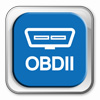 OBD2 READOUTS SUPPORTED
OBD2 READOUTS SUPPORTED
Another big feature added with the release of our v2.5 systems was OBD2 support, you are still required to buy the multi gauge base pack v2.5 to use along with this gauge, as the OBD2 cable we sell connects to the Control Unit from the base pack and NOT this screen, but by installing this gauge with our multi gauge base pack v2.5 and connecting the OBD2 cable we sell separately to the Control Unit that comes with the base pack, you can now power the whole system and obtain some readouts from the vehicles OBD2 port right onto this little gauge without the need to hardwire in things like Speed & RPM, and some other readouts from the OBD2 port will display on this screen without the need to install the sensors as well.
These systems are really still designed to be standalone systems and the OBD2 support is there to compliment & simplify the install process only, and also allow customers to obtain certain readouts like Speed & RPM on these gauges without having to hardwire those back to the Control Unit. With saying that some customers will be able to obtain readouts like water temp for example from the OBDii port and so don’t have to install the water temp sensor from the base pack.
What readouts you can obtain from the OBD2 ports that can display on these gauges will depend on the vehicle, but in most cases Speed & RPM are a given, as is water temp in most cases. Again the OBD2 support added on these systems is more about a simplified install process, getting the two most tricky readouts that would normally require hardwiring being Speed & RPM, the OBD2 support is not designed to completely replace the need for installing sensors, as most vehicles OBD2 ports won’t report things like Oil Temp, Oil Pressure, Fuel Pressure for example and so that is when you would install the sensors included with the multi gauge base pack v2.5 for the readouts not being reported by the OBD2 port to get those missing readouts on the screen. Using the OBD2 install cable with the Control Unit supplies power for the system, then for example Speed, RPM, Water Temp readouts are obtained from the OBD2 port, then you would install the sensors you can’t get readings off from the OBD2 port like Oil Temp, Oil Pressure, EGT, Fuel pressure etc. Any questions on the OBD2 side of things, feel free to contact us and we will be happy to help.
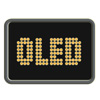 OLED SCREEN
OLED SCREEN
These multi gauges are using an OLED screen rather than LCD, this has a few advantages, one of them being they are very bright and clear to read, they also offer a much better off angle viewing than LCD, which gives you more options for placement of the screen. One of the most important aspects of a gauge is being able to read it clearly in all conditions, this is where the OLED display shines over LCD, excuse the pun. You don’t have to work around the poor viewing angles of LCD, or their weaker self-illumination, these OLED screens are bright, clear to read and can be easily read even if you have the gauge on an off angle from your line of sight.
Of course being that they are a very bright gauge, they also have a 3-state automatic brightness adjustment, there is a built in light sensor on the gauge so it can reduce or increase the brightness for you. There is also a 5-stage manual brightness adjustment if you wish to go that way.
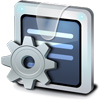 CUSTOMISABLE DISPLAYS
CUSTOMISABLE DISPLAYS
The JRP 14in1 OLED gauge has four selectable screens that you can switch between with each having a different layout of the sensors and readouts displaying on each selectable screen, two of these four screens are completely customizable, as in which sensors or readouts you want displayed on the screen and where, the size & style of the readouts as well. You can see from the screen cell breakdown charts below the different options for sizing & styling of the readouts, along with which sensors are supported by the different size & style options.
Another feature of these 14in1 gauges multi is the ability to configure KPH, MPH, PSI, KPA, Celsius, and Fahrenheit independently. So it’s possible to setup the system so it uses KPH, Celsius & PSI for pressure readings. A lot of us Australian’s like our pressure readings in PSI and not KPA, so this can be done without a problem, no need to try and learn KPA if you are used to PSI.
CELL SIZE A – STANDARD
When the cell is set to size A, you can switch between the below readouts on that cell.
| Oil Pressure | Fuel Pressure |
| Boost | Wideband AFR |
| Wideband Lambda | Volts #1 |
| Volts #2 | EGT |
| Water Temp | Oil Temp |
| IAT | Differential Pressure |
| Speed | Transmission Temp |
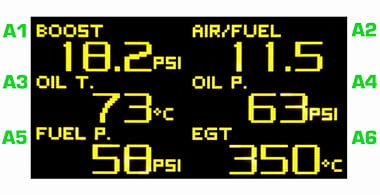
CELL SIZE B – EXTENDED
When the cell is set to size B, you can switch between the below readouts on that cell.
| Tacho Digital | Tacho Bar |
| Oil Pressure | Fuel Pressure |
| Boost | Wideband AFR |
| Wideband Lambda | Volts #1 |
| Volts #2 | EGT |
| Water Temp | Oil Temp |
| IAT | Differential Pressure |
| Speed | Transmission Temp |
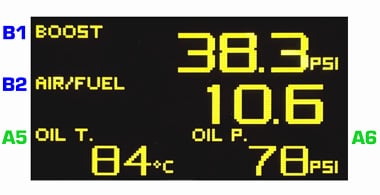
CELL SIZE C - CHART
When the cell is set to size C, you can switch between the below readouts on that cell.
| Water Temp | Oil Temp |
| IAT | Trans Temp |
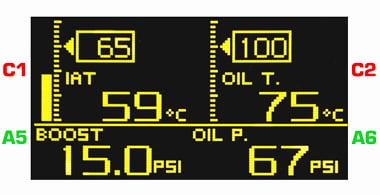
 DAISY CHAIN MULTIPLE 14IN1 DISPLAYS
DAISY CHAIN MULTIPLE 14IN1 DISPLAYS
Another great feature of our multi gauge systems is the ability to daisy chain more than one of our JRP 14in1 displays to the control unit. So it’s possible to have right up to 7 of the gauges connected to each other at once. While 7 gauges would be complete overkill, we have found some customers have definitely made use of connecting 2 or 3 gauges up to these systems at once as they are using more than 6 readouts at once and would like to see more than one gauge can display.
The JRP 14in1 gauges when using all the display cells available to their maximum can display 6 readouts from your inputs or sensors, but it’s also possible to make the first two readouts take up 2-cells and with doing that will give you a larger readout on the display for viewing purposes, but when you do this the amount of readouts on the display goes from 6 to 4. So this is where running multiple 14in1 displays comes in. Some people will have more than 6 readouts they would like to see, so while using the smallest readout display and running two gauges it will allow for a total of 12 readouts to display across two gauges. Or, if the customer would like to use the larger readouts, running two gauges means they can have a total of 8 readouts displayed across the two gauges, and 4 of those readouts will be much larger than normal. Some of our product photos on this page show the larger readouts that we mention in this section, and the customisable displays section above runs over the different layouts and sizes you can choose from.
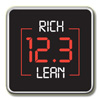 PETROL WIDEBAND DISPLAY SUPPORTED
PETROL WIDEBAND DISPLAY SUPPORTED
For those wanting a complete solution and don’t currently have a wideband setup in their car and would like to also monitor their air fuel ratios on these 14in1 gauges, we are proud resellers of 14point7 wideband products and we sell their Spartan 3 Lite wideband controller kits which are compatible with these systems and can be connected directly into the control unit which comes with the multi gauge base pack, and then the wideband signal from the Spartan 3 Lite is sent to this gauge so you can also use this system as your wideband display for air fuel ratios as well. The gauges can display 10 to 20 AFR or 0.68 to 1.36 Lambda for petrol applications when a compatible wideband like the Spartan 3 Lite is connected, you can take advantage of the wideband lean out warning which we explain further below, and the advantages of using Lambda as opposed to AFR for alternative fuels like e85, methanol etc. For a little more information on the wideband connection side of things, checkout the multi gauge base pack’s page where we talk more about the specifics of using a wideband with these gauge systems.
Below we have a link you can click on which will take you to our Spartan 3 Lite compatible wideband kit, this would be the wideband kit to order if you are running unleaded, e85, methanol fuels and are looking at getting Air Fuel Ratio or Lambda to display on the 14in1 screen. They are one of the best wideband kits available in the world today and at a terrific price.
Cick Here
For Petrol Compatible
Spartan 3 Lite Wideband
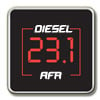 DIESEL WIDEBAND DISPLAY SUPPORTED
DIESEL WIDEBAND DISPLAY SUPPORTED
Since releasing our v2 models in 2018, we have gained a huge following from the off-road, on-road 4x4 community, we put a lot of time & effort into the v2 models to cater for the 4WD crowd, and that has made many happy customers over the years. But many times we had been asked by our 4x4 customers if they could connect a wideband up to our kits to read air fuel ratios for Diesels which you could not with the v2 models. The issue with Diesels is that the AFR range required for diesel tuning is different to that of petrol, the standard AFR range for petrol is 10-20 AFR and this range was just too narrow for diesel tuning. So when we were working on the v2.5 models, we have done two things, one was program the gauges to be able to display an AFR range that was suitable for diesel tuning which is 10 to 40 AFR, and second was work with our good friends over at 14Point7 to create a diesel wideband controller that would be able to be bought and run in parallel with our multi gauge system to provide a wideband kit that could be run into our gauge systems that could provide an AFR range suitable for diesel tuning.
These Spartan 3D Lite Diesel wideband controller kits are now on our website for sale, pop over to their page to have a read about what makes these such a great Diesel wideband solution to use with these systems. The Spartan 3D Lite Diesel wideband is the product you would order along with this gauge & the base pack if wanting to monitor air fuel ratios on Diesel motors and have them display right up on the 14in1 screen.
Make sure not to confuse the Spartan 3D Lite diesel wideband with the standard Spartan 3 Lite, as the Spartan 3 Lite is meant for petrol applications and not Diesel, so once again the wideband you would grab if wanting the 10 to 40 AFR range for Diesels would be the Spartan 3D Lite diesel. We have linked below to the correct page so you can check them out.
Click Here
For Diesel Compatible
Spartan 3D Lite Diesel Wideband
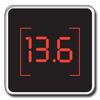 WIDEBAND AIR FUEL RATIO LEAN WARNING
WIDEBAND AIR FUEL RATIO LEAN WARNING
One of the latest features added to these gauges is a wideband air fuel ratio lean out warning, for those customers that plan on using a wideband connected to these gauges, this is really a massive deal. The purpose of the wideband lean out warning is to let you know if your car starts to run air fuel ratios leaner than what is normal or the car was tuned for, this can be configured to meet requirements of both boosted and NA cars. Wideband gauges alone with this feature can set you back over $500AUD, when you either buy the Spartan 2 wideband we sell to use with these gauges, or use your existing wideband if it supports an analog out 0-5v 10-20 AFR, you can make use of this exciting and powerful new warning feature.
Let’s face it, while we all periodically stare at our various gauges from time to time when driving, some more than others, if your car suddenly goes from running its tuned 11.5 AFR to 14.5 AFR when running boost, it would not take long before some pretty catastrophic detonation could occur. This is not something you really want to leave up to human detection, the time frame where engine damage could occur from a situation like this is far too short. So having a wideband lean out warning such as this, could very well help you catch a situation within seconds where something went wrong with your fuel system and you suddenly started to run extremely dangerous air fuel ratios for your motor.
We have written a detailed blog post about this latest wideband air fuel ratio warning, how it works and explaining the settings used to set it up correctly, click here to take you to that page.
 LAMBDA OR AFR SELECTABLE READOUT
LAMBDA OR AFR SELECTABLE READOUT
Another feature that was added in this latest revision is now the ability to select between AFR or Lambda readouts for the Wideband input. The version before had just AFR readings of 10-20 which is the range used for petrol, now while you can still use this on fuels like e85, ethanol etc, it’s not the working range people are used to when dealing with fuels other than pump petrol. It’s now possible to switch the gauge to displaying 0.68 to 1.36 Lambda readings which is the wideband controller’s native reading before it’s converted to AFR on gauges.
This now means if you are running e85, methanol, and ethanol fuels that you can use Lambda to gauge your fuel mixture. Some tuners and customers actually prefer using Lambda even for pump petrol, so this should appeal to a wide range of customers having Lambda as a display option for the wideband readout. The Spartan 2 widebands we sell have a Lambda range of 0.68 to 1.36 and is wide enough of a range for most alternative fuels except for Diesel.
Just like firmware v1.2 where there was a wideband lean out warning added, this function will also work with Lambda, so you can setup the highest Lambda reading you would like before a warning is triggered while under a certain level of boost or WOT on an NA setup.
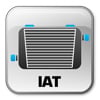 AIR INTAKE TEMPERATURE READOUT
AIR INTAKE TEMPERATURE READOUT
With the edition of an IAT sensor to the v2 control unit & sensor package, this has now given the ability for these gauges to display and monitor air intake temperatures. This is an important thing to keep an eye on with turbo & supercharged vehicles so you can monitor their air intake temps after their intercooler. Almost all aftermarket ECU’s use these sensors as they can play a pretty decent role in how the tune is setup, if your temps get very high in most cases the ECU will have a curve that pulls timing if they get too hot to avoid detonation from excessive intake temperatures.
Now not everyone has an aftermarket ECU on their cars, but they are running turbo or supercharged and having a readout that can show you your air intake temps can be a very handy thing. You can assess if your intercooler is up to its job, or if out on the track really pushing it you can see when it might be a good time to back off. Same goes for the 4x4 guys, being able to see intake temps is a very handy thing to have.
Now even if you do have an aftermarket ECU, while the ECU will be taking the readings from its own sensor into account, in most cases unless you have some kind of dash display setup reading from the ECU, you won’t get to see what IAT are doing, installing the second sensor from this kit will give you a visual display of temps that you can monitor as well as the ECU doing its thing.
Just like all the other sensors and readouts on these gauges, you can setup a warning system that if your intake temps start getting too hot the gauge will alert you. We feel the addition of this sensor and readout was a big step towards making these kits such a complete engine monitoring system.
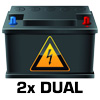 INDEPENDENT DUAL VOLTS READOUTS
INDEPENDENT DUAL VOLTS READOUTS
Another edition to the v2 control unit was a dedicated second volts input, this now allows these gauges to give two independent volts readouts. This was done mainly for the 4x4 crowd who have really taken to these multi gauges, most 4x4 people will have auxiliary batteries in their vehicles where monitoring their voltage is important to them, so the second volts was added. The unit senses the first volts from the power being supplied to the control box, and the secondary volts has its own dedicated input on the control box itself. Both primary and secondary volts are able to have warnings set independently as well on the multi gauge display.
Now for our performance or track car customers who might think this feature won’t be of use to them, well we think it actually can and in a pretty cool way. Voltage drop to fuel pumps can’t be an issue in some applications, any drop in voltage to your fuel pump can lead to drops in flow and possible changes to fuel pressure. So in a performance or track car setup, you would run a line back from the power wire powering the fuel pump and you can closely monitor your fuel pumps supply voltage, and also setup a warning that will help you catch if there is any voltage drop happening at the pump.
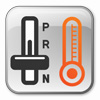 TRANSMISSION TEMPERATURE READOUT
TRANSMISSION TEMPERATURE READOUT
The latest v2.5 JRP 14in1 gauges come the addition of a Transmission Temperature readout, this readout can be obtained a couple of ways. The v2.5 multi gauge base packs Control Unit now has the ability to swap out the IAT sensor and install a Trans Temp sensor which we sell separately instead onto the port the IAT would normally connect to, we talk about this more on the base packs product page. The other option to have Trans Temp display on these gauges without having to buy another sensor is you can now select in the gauge itself if the sensor connected to the Water Temp port on the control unit displays Water Temp or Trans temp on the screen. Some people don’t really require Water Temp and have a factory water temp gauge they are happy with, if that is the case you can install what would normally be the water temp sensor into your transmission and with a simple setting change on this gauge itself you can change that sensor from displaying as water temp to trans temp.
 ON-BOARD LOGGING & PEAK VALUES DISPLAY
ON-BOARD LOGGING & PEAK VALUES DISPLAY
This gauge also has a pretty handy on-board logging and peak values display. While the logging isn’t like that of an aftermarket ECU where you can download it and analyse on a PC, it’s still a pretty handy little system. You are able to record up to 3min of driving time, and all the values on each sensor in real-time, so that you can play back the 5min log on the gauge itself to analyse. We also find this system helpful when it comes to setting up certain functions on the gauge, for example the oil pressure warning. To properly setup the oil pressure warning, you need to see what your oil pressure is at a certain rpm normally to input a value for the warning that the gauge can use, this logging allows you to record and then replay a run so you can work out your warning values for things like oil pressure, fuel pressure, differential pressure. Each of these warning values will vary from motor to motor, so being able to log and playback can come in very handy to help decide on the appropriate values to use for the warnings.
The peak display is also another cool little feature, when in peak mode, you can have 5 readouts on the screen at once, and the unit will update each readout with the highest value it has recorded for that given sensor or input. All sensors and inputs are supported in this mode, so you can get peaks on your boost, oil & water temp, oil & fuel pressure, EGT, volts, RPM & speed. This is not limited to 5min like the logging function, you can happily leave the gauge in peak mode if you so wish and it will continue to update the peak values. Again this can also be a good way to determine appropriate values for some of your warning alarms, for things such as boost, oil & water temp, EGT, you can give the car a good hard drive and then establish the most practical values for those warnings. Note that the warning alarm system is also still active in this mode, so if you do go above an already set warning value, you will still be alerted by the gauge.
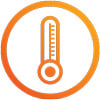 SENSOR CALIBRATION & SELF DIAGNOSIS SYSTEM
SENSOR CALIBRATION & SELF DIAGNOSIS SYSTEM
Another feature of the gauge is that you can calibrate the boost, oil pressure and fuel pressure sensors. As sensors age, they can start to read slightly off, for example the boost sensor at atmospheric pressure the sensor is now showing 0.1psi or 0.2psi on the gauge when it should be reading 0.0psi. Some sensors when they come from the factory can be just slightly out, again example 0.1psi. What you can do with this gauge is calibrate to offset these slight variations. So if your sensor is reading 0.1psi on the gauge when it should be 0.0psi, then you can add a -0.1psi to the calibration to bring it back to a 0.0psi display on the gauge.
Another bonus of this system being digital is that this gauge has a built in error diagnosis. If any of your sensor cabling has shorted out for any reason, its display on the gauge will change to SHORT. Or if the sensor has become disconnected while driving, the screen will display OPEN on the sensors readout. This can be handy if a sensor stops working, you have a good idea why.
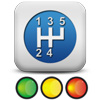 PROGRAMMABLE SHIFT LIGHT INDICATORS
PROGRAMMABLE SHIFT LIGHT INDICATORS
Another feature of this little gauge is it’s built in programmable shift lights with 8 LED’s, it has multiple colours that can be selected for the indicator lights, red, blue, green, white, yellow, cyan, purple, multi-colour and the new edition of race which is a combination of green, yellow and red. For the race selection, the first three lights will be green, next three yellow and the remaining two lights will be red.
The way the shift lights can be configured to illuminate throughout the rev range is fairly customisable. For example, you would first setup the rev limiter warning in the gauges warning setup, this dictates the end of the light sequence, so for this example let’s say its 7000rpm. Now the gauge then has four RPM step options for the LED’s which will dictate how wide the RPM scale of the lights are, these are 100rpm, 200rpm, 250rpm & 500rpm.
So for example, if you select 100rpm and have your tacho warning set at 7000rpm, the shift lights will start to come on at 6200rpm and finish at 7000rpm. Or if you selected say 250 RPM, the lights would start illuminating at 5000rpm and finish at 7000rpm.
This little system can be setup in a few ways and is a really decent little shift light system. You can also setup the tacho warning slightly below the actual rev limiter on the motor itself, what this will then do is when you exceed the RPM set in the warning setup, the gauge will also put out a loud warning beep on top of the shift lights finishing their range, so you will have a visual and audible indication you missed your shift point.
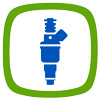 DIFFERENTIAL FUEL PRESSURE
DIFFERENTIAL FUEL PRESSURE
One of the additional features that can be used with these gauges when you have connected both the fuel pressure and boost sensor is what’s called “differential fuel pressure”. This readout can be very handy in making sure your fuel system is up to the job. It’s not necessarily something you will use all the time, but it’s great to have when your car is being dyno tuned, and in future to make sure there are no fuel supply issues. It’s more used as a diagnosing tool, sure we have AFR readings, but if they start to go out and you don’t know why, having differential fuel pressure readout can help you determine if the problem is coming from your fuel system. We will write an article on our blog that goes into detail about what differential fuel pressure readings are and how they can help.
 ADVANCED WARNING ALARM SYSTEM
ADVANCED WARNING ALARM SYSTEM
One of the most practical and in our opinion most important features on any gauge system is the ability to setup warning alarms for the sensors. These multi gauges support warning alarms to be set for oil temp, water temp, oil pressure, fuel pressure, boost, EGT, air fuel ratios, differential pressure, RPM and even speed. When out on the track, you don’t want to be looking at the gauge every 10 seconds to make sure you aren’t about to cook the oil, dropping oil pressure or anything else nasty that could cause engine damage. With the huge array of warnings that can be setup on these gauges, you can focus on driving and enjoying the car while knowing this little gauge is keeping an eye on everything for you and if there is a problem, it will let you know.
Example is you can have oil temp set to trigger the units alarm if it reaches over 110c, or another is to be able to have oil pressure trigger an alarm if oil pressure drops below say 50psi while the motor is over 5000rpm. The oil pressure warning system is pretty cool and was updated in firmware v1.1 of these gauges, if you would like to see an example explanation of how the oil pressure warning works differently to that of other oil pressure warnings, have a read of the blog post about the firmware v1.1 update which is linked to from the related articles tab at the top of this page. This article also explains the fuel pressure warning setup, which like the oil pressure warning is done differently to how other gauges would handle this type of warning.
If a warning is triggered apart from the unit beeping, it will highlight the sensor which triggered the alarm on the screen. If the screen you have selected does not currently have the sensor which triggered the alarm displaying, the bottom left hand cell on the gauge is a multi-cell. So let’s say Oil Temp triggered a warning alarm, but the screen you have the gauge set to does not have Oil Temp as part of the screen configuration and you have boost in the bottom left of the screen, where the boost is will change to a highlighted Oil Temp along with the unit beeping so you know exactly which sensor has triggered the alarm.

